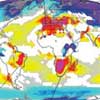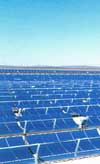ESRL Quarterly Newsletter - Spring 2009
The ESRL quarterly newsletter provides highlights of ESRL's diverse research programs and explains how these are integrated to form a more complete understanding of our Earth system.

International Study: Climate Change Irreversible
ESRL’s Susan Solomon leads study showing effects will last 1,000 years+
Significant sea level rise, temperature increases, and shifts in rainfall are irreversible consequences of people’s emission of carbon dioxide, CO2, according to a new study led by ESRL’s Susan Solomon. Climate changes wrought by the greenhouse gas will persist for more than 1,000 years, the new study shows, even if people on this planet instantly stopped emitting carbon dioxide—by curbing the burning of fossil fuels in cars and power planets, among other actions. more...

Ozone Smog in Wyoming
ESRL solves mystery of winter highs
Ozone pollution is normally linked to hot summers in big cities, so researchers were puzzled when ozone levels soared dangerously high during the past three winters in a rural Wyoming gas field. At high levels, surface ozone can damage people’s lungs and harm ecosystems.
Now, ESRL scientists have figured out how the pollutant forms in the cold, and their results suggest that wintertime ozone formation could be a more widespread problem than believed. more...
Director’s Corner
How Does ESRL Science Serve Society?
NOAA Administrator Dr. Jane Lubchenco has called for “a new social contract for science” stating that this contract “represents a commitment on the part of all scientists to devote their energies and talents to the most pressing problems of the day . . .” (Lubchenco, 1998). How do we in ESRL see the results of our scientific efforts applied to the pressing problems of the day? Can our science affect the future, without putting us in a position of being advocates of specific policies? As Dan Albritton used to emphasize, we must assure that our policy relevant science is presented from the position of being honest brokers of scientific information. more...
By the Numbers
1,679,394
The number of CPU hours—on supercomputers at Lawrence Berkeley National Laboratory—it took to run a “reanalysis” of global atmospheric conditions for 1908 to 1958, based on historic weather measurements. That’s 192 years on a single PC.

Reconstructing History
Understanding past weather to improve forecasts
Today, weather instruments around the globe collect millions of observations daily, giving forecasters and others a fairly comprehensive view of the global atmosphere and upcoming weather. A century ago, a few hundred observers on land and sea—most in the Northern Hemisphere—recorded a few thousand observations a day, at best. Now, ESRL researchers and colleagues around the world have produced realistic guesses at historic atmospheric conditions, based on sparse observations and an understanding of the way the atmosphere behaves today. This is the kind of detailed information that climate and weather researchers and historians have longed for, but accurate information has not been available beyond the past 60 years. The 20th Century Reanalysis project will eventually provide global surface and lower atmosphere weather data from the 1870s to the present. more...
Climate Services Update
A new National Climate Service (NCS) is taking shape within NOAA, with ESRL’s help. In late January, Deputy Undersecretary Mary Glackin announced the appointment of Tom Karl as Director of NOAA’s Climate Services, and Chet Koblinsky as Deputy Director. more...

From Pole to Pole
HIPPO Mission: a global picture of the atmosphere, greenhouse gases
Carbon dioxide and other pollutants are higher in concentration over the Arctic than many scientists expected, and more oxygen is piling up over the Southern Ocean, according to initial data from HIPPO, a multiagency, multiyear mission to paint a three-dimensional portrait of the atmosphere. more...

Technology Export
Australian meteorologists are now using customized ESRL technology to issue detailed, daily weather forecasts for the Victoria region, including parts of Australia hit hard by wildfires this year. This is the second international technology transfer for the Graphical Forecast Editor, or GFE, which is also being used in Taiwan for marine forecasts. more...

Geoengineering Problems
Proposals to lessen global warming by shooting light-scattering particles into the stratosphere could significantly reduce solar power production, a new ESRL study shows.
To slow climate change, several climate scientists have described geoengineering schemes, which would attempt to cool the planet by injecting particles into the upper atmosphere. Such “aerosol loading” would be similar to the effect of volcanic eruptions, which create particles that scatter sunlight to outer space and cool Earth’s surface. more...
Upcoming @ ESRL
April 28-29: The First NOAA Testbed US Weather Research Program Workshop, to build collaborations and exchange information on a variety of testbed projects, including those from the Joint Hurricane Testbed, the HydroMeteorological Testbed, Collaborative Science, Technology, and Applied Research, the Societal Impacts Program, and the Development Testbed Center.
May 13-14: ESRL Global Monitoring Annual Conference, “21st Century Challenges for Long-Term Monitoring.”
May 26: ESRL will host approximately 20 Hollings, Educational Partnership Program and Interdisciplinary Scientific Environmental Technology scholars this summer. Please join Dr. MacDonald as he welcomes the students at a reception.
The National Academy of Sciences
The National Academy of Sciences launched in November 2008 a series of studies called America’s Climate Choices, requested by members of Congress seeking guidance on responding to climate change. The study is due in 2010, and its charge is to “investigate and study the serious and sweeping issues relating to global climate change and make recommendations regarding what steps must be taken and what strategies must be adopted in response to global climate change, including the science and technology challenges thereof.” more...

India and Drought
ESRL scientists help India plan national drought network
ESRL’s Robin Webb and Roger Pulwarty traveled to India in January, at the request of government officials there seeking advice about establishing a drought early warning information system similar to the US National Integrated Drought Information System, NIDIS.
Pulwarty and Webb helped develop NIDIS, which integrates drought risk, impacts, adaptation information, and expertise from several government agencies and research institutions.
“The Indian officials wanted to talk with us about the organizational part of this, the infrastructure,” Pulwarty said. “They’ve got the scientific and technical capacity. They’re just trying to figure out how to make it all work together as an effective information system.” more...
